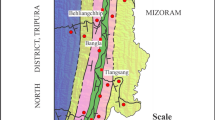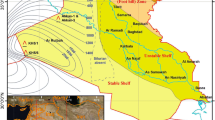Abstract
The sandstones of the Bhuban Formation (Miocene) exposed in the Jampui hills of Tripura Fold Belt, India has been studied for provenance, tectonic setting and paleoclimate using the petrography, heavy mineral assemblage and clay mineral studies. The detrital mode of the sandstones indicate that the sediments consists predominantly of detrital quartz (avg. 92.19%), with subordinate proportions of feldspar (avg. 4.55%) and rock fragments (avg. 3.25%). The provenance discrimination diagrams depict the derivation of the detritus from both plutonic and metamorphic source rocks having affinity to continental block provenance. The plots of QFR and semi quantitative weathering index of the clastics support a moderate degree of paleoweathering in the source area under humid climatic condition. The presence of zircon, tourmaline, rutile, kyanite, epidote, sillimanite and garnet in the Bhuban sandstones is ascribed to the provenance of plutonic and metamorphic rocks. Dominance of zircon in the heavy mineral assemblage and the ZTR index values (75.13% avg.) indicate towards moderate degree of maturity with long distance of transport. The study of the shale samples by XRD and SEM analyses shows the dominance of illite over kaolinite and montmorillonite. The presence of minor amount of montmorillonite may suggest the addition of tuff and volcanic ash in the sediments under alkaline environment.
Similar content being viewed by others
References
Acharyya, S. K. (2010) Tectonic evolution of Indo Burma range with special reference to Naga Manipur Hills. Mem. Geol. Soc. India, no.75, pp.25–43.
Aitchison, J.C., Ao, A., Bhowmik, S., Clarke, L.G., Ireland, R.T., Kachovich, S., Lokho, K., Stojanovic, D., Roeder, T., Truscott, N., Zhen, Y., and Zhou, R. (2019) Tectonic Evolution of the Western Margin of the Burma Microplate Based on New Fossil and Radiometric Age Constraints. Tectonics. doi:https://doi.org/10.1029/2018TC005049.
Basu, A., Young, S.W., Suttner, L.J., James, W.C. and Mack, G.H. (1975) Re-evaluation of the use of undulatory extinction and polycrystallinity in detrital quartz for provenance interpretation. Jour. Sediment. Res., doi:https://doi.org/10.1306/212F6E6F-2B24-11D7-8648000102C1865D.
Blatt, H., Middleton, G. and Murray, R. (1980) Origin of sedimentary rocks, 2nd edition, Eaglewood cliffs New Jersey Prentice-Hall, 766p.
Boggs, S. (1992) Sedimentary Petrology. Blackwell Scientific Publications.
Das, K.L. (1939) Notes on the Geology of Tripura State, Bengal. Quart. Jour. Geol. Min. Soc. India, v.II(3), pp.199–222.
Dasgupta, S. and Nandy, D.R. (1995) Geological framework of the Indo-Burmese convergent margin with special reference to ophiolite emplacement. Indian Jour. Geol., v.67(2), pp.110–125.
Dickinson, W.R. (1970) Interpreting Detrital Modes of Graywacke and Arkose. Jour. Sediment. Petrol., v.40, pp.695–707. doi https://doi.org/10.1306/74d72018-2b21-11d7-8648000102c1865d.
Dickinson, W.R., Beard, L.S., Brekenridge, G.R., Erjavec, J.L., Ferguson, F.A., Inman, K.F., Knepp, R.P., Lindberg, F.A. and Ryberg, P.T. (1983) Provenance of North American Phanerozoic sandstones in relation to tectonic setting, Geol. Soc. Amer. Bull., v.94, pp.222–235.
Dixon, J. B. (1989) Kaolin, serpentine group minerals. In Dixon J.B. (Editor), Minerals in the environment 2nd Edition. SSSA Book Series No.1, pp.467–523.
Dott, Robert H.Jr. (1964) Wacke, greywacke and matrix- what approach to immature sandstone classification? Sediment. Petrol., v.34, pp.625–632.
Feo-Codecido, G. (1956) Heavy Minerals techniques and their application to Venezuela stratigraphy. AAPG, v.40, p.984–1000.
Folk, R.L. (1974) Petrology of Sedimentary Rocks: Austin, TX, Hemphill Press, second edition, 182p.
Grantham, J. H. and Velbel, M.A. (1988) The influence of climate and topography on rockfragment abundance in modern fluival sands of the southern Blue Ridge Mountains, North Carolina. Jour. Sed. Petrol., v.58, pp.219–227. doi:https://doi.org/10.1306/212F8D5F-2B24-11D7-8648000102C1865D.
Grim R.E., and Guven N. (1978) Bentonites-Geology, Mineralogy, Properties and Uses. Developments in Sedimentology, Elsevier, Amsterdam, v.24, 256p.
Grim, R.E., and Johns, W. D. (1954) Clay Mineral Investigations of Sediments from the Northern Gulf of Mexico. Nat. Acad. Sci. Publ., no.327, pp.81–103.
Grim, R.E. (1958) Concept of diagenesis in argillaceous sediments. Bull. AAPG., v.42, pp.246–253.
Ingersoll, R. V., Bullard, T. F., Ford, R. L., Grimm, J. P., Pickle, J. D. and Sares, S.W. (1984) The effect of grain size on detrital modes: A test of the Gazzi-Dickinsom point counting method. Jour. Sed. Petrol., v.54, pp.0103–0116.
Joussein, E., Petit, S., Churchman, J., Theng, B., Righi, D. and Delvaux, B. (2005) Halloysite clay minerals— a review: Clay Minerals, v.40, pp.383–426.
Keller, W. D. (1956) Clay Minerals and Environment. Bull. Amer. Assoc. Petrol. Geol., v.40, pp.2689–2710.
Mathur, L.P. and Evans, P. (1964) Oil in India. 22nd session. In: Int. Geological Congress, New Delhi, p.85.
Milner, H.B. (1962) Sedimentary Petrography, 4th edition, McMillan, New York.
Millot, G. (1942) Relation between the Constitution and the Genesis of Argillaceous Sedimentary Rocks. Geol. Appliq. et Prosp. Min., v.2, Univ. Nancy, France.
Moore, D.M. and Reynolds, R.C. (1989) X-ray Diffraction and the Identification and Analysis of Clay Minerals. Oxford-New York, Oxford University Press, 332p.
Najman, Y., Mark, C., Barfod, D.N., Carter, A., Parrish, R., Chew, D., and Gemignani, L. (2019) Spatial and temporal trends in exhumation of the Eastern Himalaya and syntaxis as determined from a multitechnique detrital thermo chronological study of the Bengal Fan. Geol. Soc. Amer. Bull., v.131, pp.1607–1622. doi:https://doi.org/10.1130/B35031.1.
Nandy, D.R. (1980) The Eastern Himalaya and the Indo-Burrmese Orogen in relation to Indian Plate movement. Geol. Surv. India, Misc. Publ., v.43, pp.151–159.
Nandy, D.R., Dasgupta, S., Sarkar, K. and Ganguly, A. (1983) Tectonic Evolution of Tripura-Mizoram Fold Belt, Surma Basin, Northeast India. Quart. Jour. Geol. Min. Met. Soc. India, v.55, pp.186–194.
Nandy, D.R. (2001) Geodynamics of Northeastern India and the adjoining region: ACB Publ., Kolkata, 209p.
Nandy, D.R. and Dasgupta, S.C. (1971) Systematic Geological Mapping in Parts of Amarpur and Sabrum Sub-division of Tripura;. Geol. Surv. India Unpubld. Report for FS:1970–71.
Pettijohn, F.J., Potter, P.E. and Siever, R. (1972) Sand and sandstone. Springer, New York, 553p.
Pettijohn, F.J. (1984) Sedimentary Rocks. CBS Publishers and Distributors, New Delhi.
Pittman, E.D. (1963) Use of zoned plagioclase as an indicator of provenance. In: Sand and Sandstone (Ed. by Pettijohn, Potter and Siever, 1987). Jour. Sediment. Petrol., v.33, pp.380–386.
Prothero, D.R. and Schwab, F.L. (2003) Sedimentary Geology: An introduction to sedimentary rocks and stratigraphy. New York. W.H. Freeman and Co., pp.99–126.
Sen, S.N. (1951) General Report of G.S.I. Rec. G.S.I. v.84 (1), pp.52–53.
Sengupta, S., Ray, K.K., Acharyya, S.K. and De-Smeth, J.B. (1990) Nature of Ophiolite occurrence along the eastern margin of Indian plate and their tectonic significance. Geology, v.18, pp.439–442. doi:https://doi.org/10.1130/0091-7613(1990)018%3c0439:N000AT%3e2.3.CO:2.
Sinha, R.N. and Sastri, V.V. (1973) Correlation of the tertiary geosynclinals sediments of the Surma Valley, Assam and Tripura state (India): Sediment. Geol., v.10, pp.107–134.
Soibam, I. (1998) On the Geology of Manipur. In: Proceedings of 9th Manipur science congress, 25–27 Mar, Department of Earth Sciences, Manipur University, pp.12–18.
Srivastava, S.K., Pandey, N. and Srivastava, V. (2004) Tectono-sedimentary evolution of Disang-Barail Transition, North West of Kohima, Nagaland, India. Himalayan Geol., v.25, pp.121–128.
Suttner, L. J. and Basu, A. (1981) Climate and the origin of quartz arenites. Jour. Sediment. Petrol., v.51, pp.1235–1246.
Suttner, L.J. and Dutta, P.K. (1986) Alluvial sandstone composition and paleoclimate, I. Framework mineralogy. Jour. Sediment. Petrol., doi:https://doi.org/10.1306/212F8909-2B24-11D7-8648000102C1865D.
Tortosa, A., Palomares, M. and Arribas, J. (1991) Quartz grain types in Holocene deposits from the Spanish Central System: some problems in provenance analysis. Geol. Soc. London, Spec. Publ., no.57, pp.47–54. doi:https://doi.org/10.1144/GSL.SP.1991.057.01.05.
Vacheli, E.T. (1942) Note on the Tertiary Sequence in Tripura State, Bengal, G.J.G. M.M. Soc. of India, v.14(1), pp.9–120.
Weltje, G.J. (1994) Provenance and dispersal of sand-sized sediments: reconstruction of dispersal patterns and sources of sand-sized sediments by means of inverse modelling techniques. Geol. Ultraiectina.
Acknowledgement
Authors are grateful to the HOD of Applied Geology Department, Dibrugarh University for providing research facilities. We are also thankful to the Editor, B. Mahabaleswar and the two anonymous reviewers for their very constructive comments and suggestions to improve the manuscript. Special thanks to Prof. Dilip Majumdar of Applied Geology Department and also to Prof. Pradip Borgohain of Petroleum Technology Department of Dibrugarh University for providing laboratory facility to carry out microscopic study of the thin sections.
Author information
Authors and Affiliations
Corresponding author
Rights and permissions
About this article
Cite this article
Borgohain, K., Sarmah, R.K. Provenance, Tectonic Setting and Paleoclimate of the Bhuban Formation Exposed in Jampui Hills, Tripura Fold Belt, Tripura, India: Insights from Petrography and Clay Mineralogy. J Geol Soc India 98, 805–814 (2022). https://doi.org/10.1007/s12594-022-2071-5
Received:
Accepted:
Published:
Issue Date:
DOI: https://doi.org/10.1007/s12594-022-2071-5




